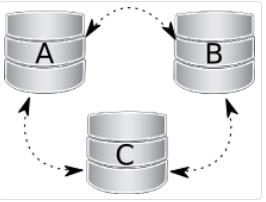galera mariadb集群恢复策略
Posted luohaixian
tags:
篇首语:本文由小常识网(cha138.com)小编为大家整理,主要介绍了galera mariadb集群恢复策略相关的知识,希望对你有一定的参考价值。
1 galera mariadb
首先MariaDB是一个数据库,可以看成是mysql的一个分支,由于MySQL被SUN收购,所以MySQL面临着闭源的风险,当时MySQL之父Widenius并没有加入SUN,而是基于MySQL的代码开发新的分支,命名为MariaDB,并全部开源。
Galera是Galera Cluster,是一种为数据库设计的新型的、数据不共享的、高度冗余的高可用方案,galera mariadb就是集成了Galera插件的MariaDB集群,Galera本身是具有多主特性的,所以galera mariadb不是传统的主备模式的集群,而是多主节点架构。
2 galera mariadb的配置方式
我的一篇OpenStack高可用模块博客中其中有一段是描述搭建galera mariadb的(2.2.1数据库服务高可用配置):OpenStack高可用方案及配置
3 galera mariadb的一些基本概念
(1)当前节点数据库状态
MariaDB [(none)]> show status like \'wsrep_local_state_comment\'; +---------------------------+--------+ | Variable_name | Value | +---------------------------+--------+ | wsrep_local_state_comment | Synced | +---------------------------+--------+
状态查询表:
| 状态 | 状态说明 |
| Open | 节点启动成功,尝试连接到集群 |
| Primary | 节点已处于集群中,在新节点加入时,选取donor进行数据库同步时会产生的状态 |
| Joiner | 节点处于等待接收或正在接收同步文件的状态 |
| Joined | 节点完成数据同步,但还有部分数据不是最新的,在追赶与集群数据一致的状态 |
| Synced | 节点正常提供服务的状态,表示当前节点数据状态与集群数据状态是一致的 |
| Donor | 表示该节点被选为Donor节点,正在为新加进来的节点进行全量数据同步,此时该节点对客户端不提供服务 |
(2)Primary Component
在网络发生故障时,由于网络连接原因,集群可能被分成好几个小集群,但只能有一个集群可以继续进行数据修改,集群的这部分称为Primary Component
(3)GTID
英文全称为Global Transaction ID,由UUID和sequence number偏移量组成,wsrep api中定义的集群内部全局事务id,一个顺序id,用来集群集群中状态改变的唯一标志及队列中的偏移量
(4)SST
英文全称为State Snapshot Transfer,即状态快照迁移:通过从一个节点到另一个节点迁移完整的数据拷贝(全量拷贝)。当一个新的节点加入到集群中,新的节点从集群中已有节点进行数据同步,开始进行状态快照迁移。
Galera中有两种不同的状态迁移方法:
<1>逻辑数据迁移:采用mysqldump命令,这是一个阻塞式的方法。
<2>物理数据迁移:该方法采用rsync、rsync_wan、xtrabackup等方法直接在服务器之间拷贝数据,接收的服务器在拷贝完数据后启动服务。
可以通过配置文件中修改SST的方式:
wsrep_sst_method=rsync
(5)IST
英文全称为Increamental State Transfer,即增量状态迁移:集群一个节点通过识别新加入的节点缺失的事务操作,将该操作发送,而并不像SST那样的全量数据拷贝。最常见情况就是该节点之前已经存在于该集群,只是关机重启了,重新加入该集群会使用IST进行同步。
(6)grastate.dat
可以通过该文件查看到该节点记录的uuid和seqno,也就是上面说的GTID,当节点正常退出Galera集群时,会将GTID的值更新到该文件中,如下:
[root@abc3 ~]# cat /var/lib/mysql/grastate.dat # GALERA saved state version: 2.1 uuid: 30ae87da-8e8e-11e8-810c-6a8da854119b seqno: 33557 safe_to_bootstrap: 0
如果该节点数据库服务正在运行,则seqno的值是-1的
(7)gvwstate.dat
当节点形成或改变Primary Component时,节点会创建或更新该文件,确保节点保留最新Primary Component的状态,如果节点正常关闭,该文件会被删除。
4 一些故障场景的恢复
(1)场景1

其中1个节点挂了,一般只需要重启A节点的服务即可
(2)场景2

所有节点都挂了,重启服务时不能单纯的全部重启,需要找状态最新的那个节点启动,且启动时需要加上--wsrep-new-cluster参数,该节点启动后其它节点再正常启动服务即可。
这里就涉及到一个关键点,那就是怎么找哪个是状态最新的那个节点,第5点介绍查找最新节点的策略。
5 恢复策略和自动恢复脚本
(1)恢复策略
<1>首先判断当前数据库集群中是否有服务在启动着,如果有则直接启动服务即可
<2>如果当前所有节点的数据库服务都挂了,则需要找状态最新的那个节点让它携带--wsrep-new-cluster参数启动,启动起来之后其它节点直接启动服务即可。
查找最新节点策略:
首先获取各节点的grastate.dat文件中的seqno值,值最大的那个就是最新的节点;如果所有节点的seqno都是-1,则去比较所有节点的gvwstate.dat文件中的my_uuid和view_id是否相等,相等的那个则作为第一个启动节点,第一个启动节点启动后,其它节点正常启动即可;如果依然未找到则需要人工干预来恢复了。
以下是我自己写的自动恢复脚本:
#!/usr/bin/python2 # -*- coding: utf-8 -*- import os import time import traceback import logging import sys # 初始化日志对象 logger = logging.getLogger("check-or-recover-galera") log_file=\'/var/log/check-or-recover-galera/check-or-recover-galera.log\' if not os.path.exists(log_file): os.system(\'mkdir -p /var/log/check-or-recover-galera/\') os.system(\'touch \' + log_file) formatter = logging.Formatter(\'%(asctime)s (filename)s[line:%(lineno)d] %(levelname)s %(message)s\') file_handler = logging.FileHandler(log_file) file_handler.setFormatter(formatter) logger.addHandler(file_handler) logger.setLevel(logging.DEBUG) import socket PORT = 10000 BUFF_SIZE = 10240 def test_connect_ok(ip): client_sock = socket.socket(socket.AF_INET, socket.SOCK_STREAM) client_sock.settimeout(3) client_sock.connect((ip, PORT)) client_sock.close() # 这个方法要求在要远程的节点上需要有个进程在监听PORT端口等待处理命令 def send_request(ip, data, timeout=60): test_connect_ok(ip) client_sock = socket.socket(socket.AF_INET,socket.SOCK_STREAM) client_sock.settimeout(timeout) client_sock.connect((ip, PORT)) client_sock.send(data) ret_data = client_sock.recv(BUFF_SIZE) client_sock.close() return ret_data def remote_send_request(ip, data, timeout=60): res_remote = send_request(ip, json.dumps(data), timeout=timeout) if res_remote is None or res_remote == \'\': raise Exception(\'res_remote is null\') res_remote = json.loads(res_remote) if res_remote[\'ret_state\'] != \'success\': raise Exception(\'ret_state is not success\') return res_remote # 默认vmbr0是本地ip def get_local_ip(): cmd_out = os.popen(\'cat /etc/sysconfig/network-scripts/ifcfg-vmbr0 2>/dev/null |grep IPADDR\').read() if cmd_out and cmd_out != \'\': cmd_out = cmd_out.strip() cmd_out = cmd_out.replace(\'"\', \'\').replace(\' \', \'\') tmp = cmd_out.split(\'=\') if len(tmp) >= 2: ip = tmp[1] return ip return None # 获取各节点的seqno值 def get_all_nodes_seqno(node_ips_arr): seqno_dict = {} data = {\'req_type\': \'get_seqno\'} for node_ip in node_ips_arr: try: res_remote = remote_send_request(node_ip, data) seqno_dict[node_ip] = res_remote[\'seqno\'] except Exception,e: seqno_dict[node_ip] = -1 logger.error(traceback.format_exc()) return seqno_dict # 获取各节点的gvwstate.dat文件的my_uuid和view_id的比对值结果 def get_all_nodes_uv_is_equal(node_ips_arr): uv_equal_dict = {} data = {\'req_type\': \'get_uv_equal_value\'} for node_ip in node_ips_arr: try: res_remote = remote_send_request(node_ip, data) uv_equal_dict[node_ip] = res_remote[\'equal\'] except Exception,e: uv_equal_dict[node_ip] = 0 logger.error(traceback.format_exc()) return uv_equal_dict # 检查自身mariadb服务是否已经启动 def check_is_active_now(): is_active = os.popen(\'systemctl is-active mysqld_safe 2>/dev/null\').read() is_active = is_active.strip() if is_active and is_active == \'active\': logger.info(\'the mariadb is already up\') return True return False # 第一个启动的节点 def start_mariadb_with_wsrep(): os.system("sed -i \'s/--wsrep-new-cluster//\' /usr/lib/systemd/system/mysqld_safe.service") os.system("sed -i \'s/user=mysql/user=mysql --wsrep-new-cluster/\' /usr/lib/systemd/system/mysqld_safe.service") os.system("sed -i \'s/safe_to_bootstrap:.*/safe_to_bootstrap: 1/\' /var/lib/mysql/grastate.dat") os.system(\'systemctl daemon-reload\') os.system(\'systemctl start mysqld_safe\') # 将配置文件恢复回去 os.system("sed -i \'s/--wsrep-new-cluster//\' /usr/lib/systemd/system/mysqld_safe.service") os.system(\'systemctl daemon-reload\') time.sleep(10) if check_is_active_now() is True: return True else: logger.error(\'use option wsrep-new-cluster start mariadb failed\') return False def main(): while True: try: time.sleep(10) # 先检测自己的mariadb是否已经自己启动 if check_is_active_now() is True: time.sleep(60) continue # 这里应该先检测下thintaskd服务是否已经启动,如果还没启动则需等待 is_thintaskd_active = os.popen(\'/etc/init.d/thintaskd status 2>/dev/null |grep active |grep running\').read() if not is_thintaskd_active or is_thintaskd_active == \'\': logger.info(\'wait thintaskd service start\') time.sleep(5) # 获取当前galera的集群的各节点的ip node_ips_info = os.popen("cat /etc/my.cnf.d/mariadb-server.cnf |grep \'^wsrep_cluster_address\'").read() node_ips_str = node_ips_info.split(\'gcomm://\')[1] node_ips_str = node_ips_str.strip() node_ips_arr = node_ips_str.split(\',\') # 检测其它节点是否已经有在运行着的 data = {\'req_type\': \'check_mariadb_service\'} has_mariadb_service_on = False for node_ip in node_ips_arr: try: res_remote = remote_send_request(node_ip, data) state = res_remote[\'state\'] if state == \'active\': has_mariadb_service_on = True # 找到在运行着的节点 logger.info(\'find the running mariadb service node:\' + node_ip) # 直接启动自己服务 os.system(\'systemctl start mysqld_safe\') time.sleep(10) if check_is_active_now() is True: time.sleep(60) else: logger.info(\'start mariadb service error\') break except Exception,e: logger.error(traceback.format_exc()) logger.error(\'check_mariadb_service for \' + node_ip + \' failed, error:\' + e.message) if has_mariadb_service_on is True: continue # 如果所有节点的mariadb都没在运行,则需要寻找一个节点进行启动 seqno_dict = get_all_nodes_seqno(node_ips_arr) logger.info(\'get seqno_dict:%s\', seqno_dict) # 根据seqno值判断哪个节点为启动节点 first_boot_node = None max_seqno = -2 for key in seqno_dict: if seqno_dict[key] > max_seqno: max_seqno = seqno_dict[key] first_boot_node = key if first_boot_node is not None: logger.info(\'find the first_boot_node by seqno, first_boot_node:\' + first_boot_node) # 判断这个启动节点是不是自己,如果是就启动,否则等待其它节点启动起来 if first_boot_node == get_local_ip(): if start_mariadb_with_wsrep() is True: time.sleep(60) else: logger.info(\'wait node \' + first_boot_node + \' start mariadb service\') time.sleep(5) continue else: logger.info("all node\'s seqno is -1") # 如果所有节点的seqno都是-1则说明可能是全部主机非正常停止的,比如断电等 # 这时则通过比对gvwstate.dat文件的my_uuid和view_id是否相等来决定从这个节点启动 # 当集群时干净状态停止的时候该文件是被删除的 uv_equal_dict = get_all_nodes_uv_is_equal(node_ips_arr) # 根据返回的值判断哪个是启动节点,1表示是,0表示否 for key in uv_equal_dict: if uv_equal_dict[key] == 1: first_boot_node = key logger.info(\'find the first_boot_node by uv_equal_dict, first_boot_node:\' + first_boot_node) break if first_boot_node is not None: # 判断这个启动节点是不是自己,如果是就启动,否则等待其它节点启动起来 if first_boot_node == get_local_ip(): if start_mariadb_with_wsrep() is True: time.sleep(60) else: logger.info(\'wait node \' + first_boot_node + \' start mariadb service\') time.sleep(5) continue else: logger.info("can not find first_boot_node by gvwstate.dat file") # 如果经过上述步骤依然找不到启动节点,需要人工进行干预了,或者可以随机挑选个节点进行启动 logger.error(\'can not find first_boot_node, maybe you should ask admin to deal with this problem\') time.sleep(5) except Exception,e: logger.error(traceback.format_exc()) logger.error(\'error:\' + e.message) if __name__ == "__main__": sys.exit(main())
以下是自定义的mysqld_safe.service服务的文件,你可以将它放在/usr/lib/systemd/system/mysqld_safe.service
[Unit] Description=Thinputer API Server After=syslog.target network.target [Service] Type=notify NotifyAccess=all TimeoutStartSec=0 User=root ExecStartPre=/usr/libexec/mysql-check-socket ExecStartPre=/usr/libexec/mysql-prepare-db-dir %n ExecStart=/bin/mysqld_safe --defaults-file=/etc/my.cnf.d/mariadb-server.cnf --user=mysql [Install] WantedBy=multi-user.target
以上是关于galera mariadb集群恢复策略的主要内容,如果未能解决你的问题,请参考以下文章